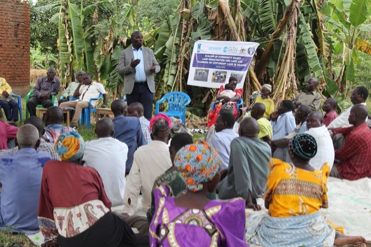Wetlands are among the most important natural resources in Uganda. They protect the country’s water resources, and are important for sustaining agricultural productivity and rural livelihoods, particularly in areas with low or unpredictable rainfall, land scarcity, or where surrounding land has low potential for agriculture. Approximately 11 percent of Uganda’s total area is covered by wetlands, either as seasonal, permanent or swamp forest[1]. But, an increasing population and its associated economic and food security pressures, lead to exploitation, degradation and considerable loss of these valuable resources. A recent report by Uganda’s ministry of Water and Environment indicated that by 2040 Uganda will be left with only 1.6% of its wetlands if destruction continues at the current rate. In this last blog on climate change within the LAND-at-scale program, we talk to Jordana Wamboga, Project officer with GLTN implementing partner UCOBAC, who works with communities in wetland areas in the Butaleja district, Uganda.
The LAND-at-scale intervention works with communities in and around wetland areas. How has climate change impacted these communities, and what has been the effect on the wetlands?
Uganda is by and large a tropical climate country that has been receiving stable weather patterns. But recently these patterns are not stable anymore. The impact of climate change in Uganda has been apparent with two failed rainfall seasons this year which have left many Ugandans grappling with critical food insecurity. At the same time, farmers report climate change dynamics especially with heavy out-of-season rains. It is in parts of eastern Uganda, like Butaleja where we implement the LAND-at-scale project, where the impact of climate change has been most visible. Like the rest of Uganda Butaleja is mainly an agricultural district with 88.7% of its income derived from natural resources. But with an increase in population, marshlands in the district have reduced from 40% to 20% due to activities such as rice growing and establishment of settlements. Wetlands are a critical ecology because they provide a wide spectrum of aquatic habitats, widely recognized as biodiversity hotspots, and also provide ecosystem goods (e.g. food and drinking water) and services (e. g. water purification, climate regulation and flood regulation) for the welfare of communities in Butaleja who live around and use them. With wetlands degraded, Butaleja has been adversely affected not only with floods whenever it rains, but also the rain patterns have significantly changed which has had negative impact on the agricultural sector. The decline of agricultural output has left farmers in Butaleja in abject poverty, poor health conditions, food insecurity and low education levels as they have no money to pay school fees for their children. It is important to mention that climate change impacts people and countries in different ways which are not gender neutral due to the existing gender inequalities.
Climate change is the living reality of women who are most affected because of long standing issues of gender. Women, who are primarily responsible for provision of food and water for their families are indeed hit hardest by effects of climate change. Women’s experiences of climate change either in the context of a family, community, country or global, have implications on women’s rights. The UN Human rights Council resolution 10/4 of 25th march 2009 recognizes that the effects of climate change will be felt most acutely by those segments of the population that are vulnerable owing to geographical location, gender, age, indigenous, minority or disability. Poor women and girls suffer more because of limited access to information on climate change, forecasts and warnings, training and capacity building, and access to climate change financial resources.
How does the LAND-at-scale intervention address the issue of climate change for these communities?
One of the pillars of LAND-at-scale in Butaleja is the implementation of sustainable wetland management. By promoting climate-smart and inclusive land use planning for smallholder farmers, and particularly women, youth and vulnerable groups, the wetland users are trained in Wetland Management Planning. The initiative supports wetland users through community-led approaches to plan and manage their wetland resource as per the national wetland wise use guidelines. Wetland communities using and living near the wetland are equipped with knowledge to integrate wise use/sustainable practices that will address the impacts of degradation through conservation and restoration of the fragile wetlands. The intervention is further supporting wetland users to map and demarcate their portions and wetland buffer zones to avoid conflicts. Through the combination of the establishment of wetland management committees, the inventory of use rights, and the development of wetland management plans, LAND-at-scale contributes to wise use of wetlands.
What is the main outcome you want to see from the upcoming COP27 and why?
In the last two decades, Africa’s contribution to the global greenhouse gas emissions oscillated between 3.4% and 3.8%. Uganda, in particular, has contributed less than 0.003% of global greenhouse gas emissions, yet it has taken the brunt of the effects of climate change - with reported cases of torrential rainfall and prolonged drought. In fact, Africa is home to the 10 most vulnerable countries with Uganda being the tenth on the list. With that, we want the wealthy countries at COP27 to channel funds that would enable developing countries like Uganda to invest in resilience and coping mechanisms—such as better irrigation, improved seed varieties, strengthened health systems, and greater access to finance. The developed world, through COP27, should also channel funds that will help Africa transition to a greener future through restoring degraded tropical forests, mangrove swamps/ wetlands and peatlands. A well-funded and supervised forestry sector has the potential to accelerate the fulfillment of net zero goals in Africa besides providing social and economic benefits to rural communities.
[1] Uganda Wetlands Atlas Volume 2 (2016). Available at https://www.mwe.go.ug/sites/default/files/Uganda%20Wetlands%20Atlas%20Vo...

